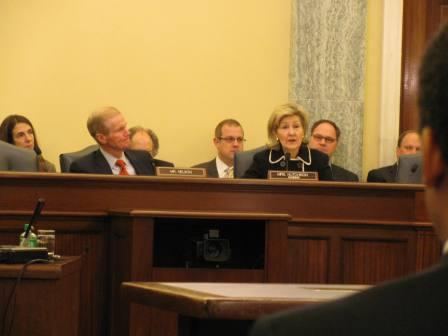NASA Administrator Charles Bolden and Senator Kay Bailey Hutchinson (R-TX) have issues. The two exchanged verbal fire on at a Senate hearing reviewing NASA's FY 2013 budget request, with Hutchinson claiming the administration had reneged on an agreement to get SLS and the Orion MPCV rolling at the cost of putting money back into commercial crew and questioning Bolden's passion toward the deep space exploration systems. Bolden fired back that he had more passion for SLS and MPCV than anyone else in the room.

In her opening statement, Hutchison said NASA's FY 2013 budget request had cut $326 million in total out of SLS -- the Space Launch System or “The Big Rocket,” as Senator Bill Nelson (D-FL) calls it -- and the Orion deep space crew capsule program. At the same time, there's a “corresponding increase” of $330 million for commercial crew in the budget, so the Administration is favoring commercial crew over SLS.
Of course, truth and consequences depends on who is holding the calculator. Last year, NASA requested $850 million for the commercial crew program to develop U.S.-flagged and launched systems for flying astronauts to the International Space Station (ISS). The Senate offered $500 million, the House $312 million and NASA ended up with $406 million as the two houses simply split the difference.
By Hutchinson's math, NASA's FY 2013 request for $830 million for the commercial crew translates to $330 million more than last year's Senate number -- not what NASA actually got or what the Administration asked for.
NASA continues to point out that it requested $850 million for the commercial crew last year, otherwise the program would “move to the right” from a 2016 operational date to 2017. They didn't get it, so the in-service date for flying U.S. astronauts has been delayed a year, resulting in having to pay the Russians between $450 million and $480 million more to fill the gap in crew transportation by buy seats on Soyuz spacecraft.
Hutchinson pushed the idea of downselecting to fewer companies within the commercial crew program -- a theme that seems to be popular among the Congressional delegation from Texas as a whole -- citing the F-35 Joint Strike Fighter program as an example. Bolden said the F-35 wasn't a good example -- a thought echoed in snorts and snickers among those attended the hearing -- and said there was a “long road” to go to get to two companies and signing a contract.
Bolden expects after the next 14 to 20 month phase of the commercial crew program, NASA will “get a good product” and ready to sign a contract in 2017, with “American companies using American vehicles” signing contracts to provide flights to ISS.
Nelson stayed out of the more energetic exchanges between Bolden and Hutchinson. He said he was “sympathetic” that NASA needed more than $406 million to meet 2017 commercial crew availability, but, “In constrained budget times, where are we going to get it? Don't take it out of the Big Rocket or Orion.”
Edited by Jennifer Russell
 Internet Telephony Magazine
Click here to read latest issue
Internet Telephony Magazine
Click here to read latest issue CUSTOMER
CUSTOMER  Cloud Computing Magazine
Click here to read latest issue
Cloud Computing Magazine
Click here to read latest issue IoT EVOLUTION MAGAZINE
IoT EVOLUTION MAGAZINE




